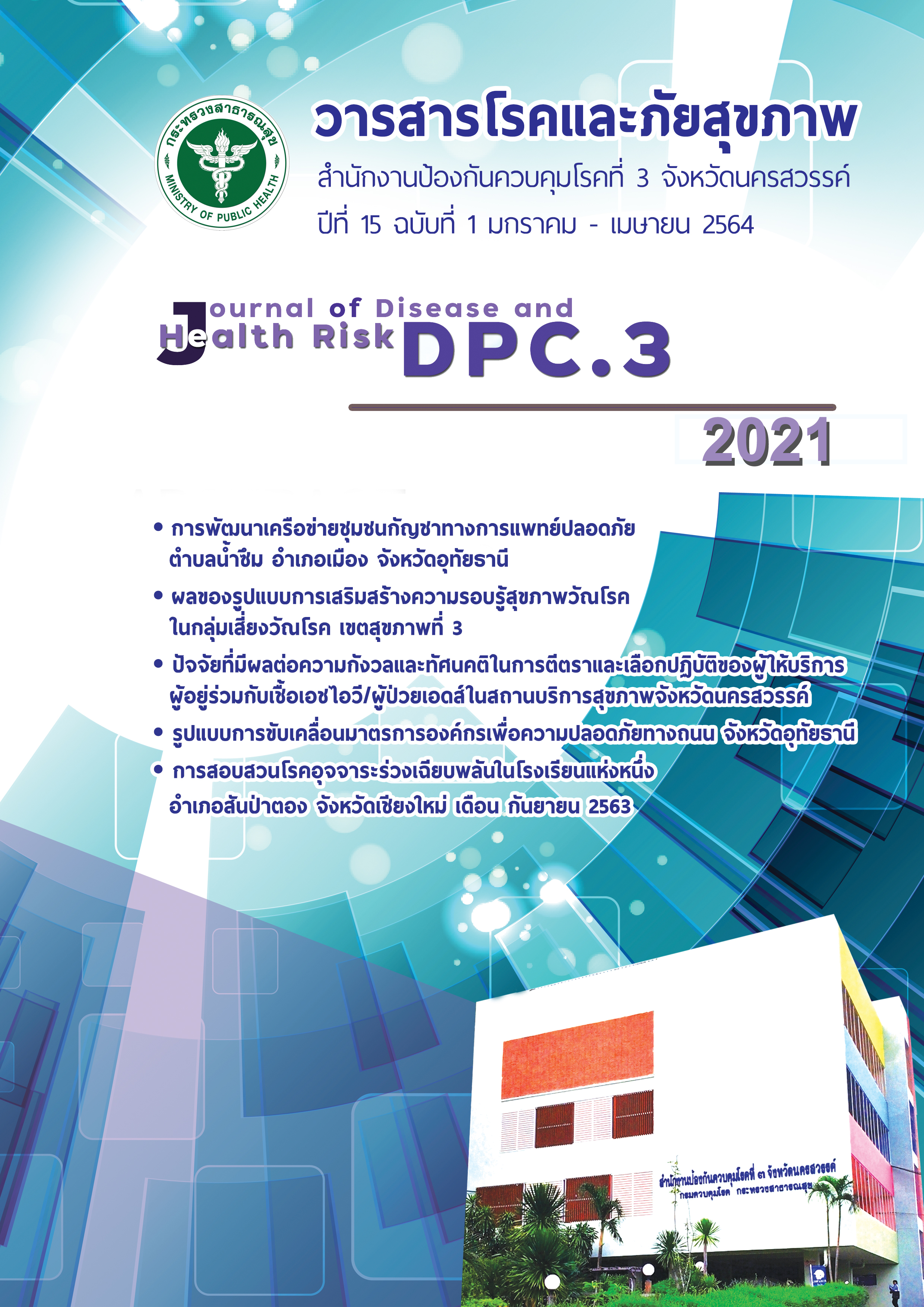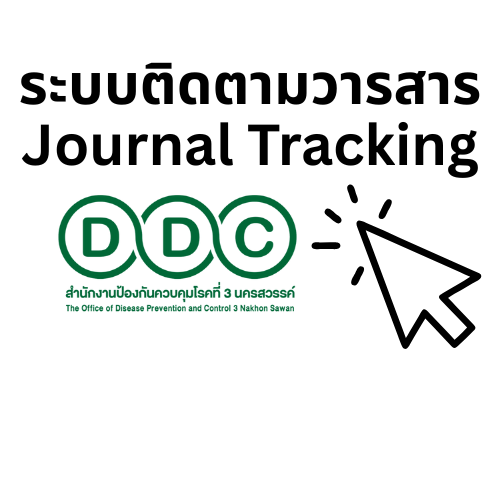Factors that affect create concerns, affect the attitude, stigma and discrimination to health care provider who lived with HIV patients in Nakorn Sawan health Care Service Center
Keywords:
Concern, Stigma and discrimination, Who lived with HIV/ AIDS PatientsAbstract
The objectives of the study are concerns, attitude, stigma and discrimination to health care provider who lived with HIV patients in Nakorn Sawan health Care Service Center and to study factors that affect create concerns, affect the attitude, stigma and discrimination to health care provider who lived with HIV patients in Nakorn Sawan health Care Service Center. The research conveys through Cross-sectional survey. The instrument was a questionnaire. Study population are those who operate at the health care service, offices, through simple random sampling, from the hospital list in Nakorn Sawan Province, data collection between 1-30 September 2019. The study result is that concerns and attitude stigma and discrimination to health care provider who lived with HIV patients in Nakorn Sawan health Care Service Center overview and all aspects are at the meddle level and concerns were HIV prevention, environment in health care facilities and agency policies affect the attitude stigma and discrimination to health care provider who lived with HIV patients in Nakorn Sawan health Care Service Center by 3 independent variables had a forecast of 63.0 percent. The executive should arrange for all new operators the training on the stigma reduction, and develop additional courses on anxiety and attitude towards those who stay with the disease and the HIV patients through on-line system, including annual follow - ups and assessment.
References
กรมควบคุมโรค. การควบคุมโรค. กรุงเทพฯ: กรมควบคุมโรค; 2560.
เกียรติ รักษ์รุ่งธรรม. เอดส์ : การวิจัยทางคลินิก. นนทบุรี: สหมิตรพริ้นติ้ง; 2561.
มัทนา หาญวนิชย์. การดูแลรักษาผู้ติดเอดส์. กรุงเทพมหานคร: ดีไซร์; 2560.
กัลยาณี จันธิมา. สถานการณ์การตีตราและเลือกปฏิบัติจากเอชไอวีในเขตสุขภาพที่ 9 ปี 2560. วารสารสำนักงานป้องกันควบคุมโรคที่ 9; 2560: ปีที่ (9) หน้า 13-24.
เพ็ญพักตร์ อุทิศ, ณิชกุล ขันบุตรศรี. คู่มือการดูแลตนเอง เรื่อง เสริมสร้างคุณค่า ลดการตีตราตนเอง. กรุงเทพฯ: จุฬาลงกรณ์มหาวิทยาลัย; 2561.
ศูนย์อำนวยการบริหารจัดการปัญหาเอดส์แห่งชาติ สำนักโรคเอดส์ วัณโรค และโรคติดต่อทางเพศสัมพันธ์ กรมควบคุมโรค กระทรวงสาธารณสุข. ยุทธศาสตร์แห่งชาติว่าด้วยการยุติปัญหาเอดส์ พ.ศ. 2560-2573. กรุงเทพมหานคร : เอ็นซี คอนเซ็ปต์ ; 2560.
ศูนย์รวมข้อมูลสารสนเทศด้านเอชไอวีของประเทศไทย [อินเตอร์เน็ต] [เข้าถึงเมื่อ 5 ต.ค.2563] เข้าถึงได้จาก https://hivhub.ddc.moph.go.th
เกรียงไกร ศรีธนวิบุญชัย. โครงการ การสำรวจสถานการณ์การตีตราและการเลือกปฏิบัติ ในสถานบริการสุขภาพภาครัฐ ปี พ.ศ. 2561. กรุงเทพมหานคร : กรมควบคุมโรค ; 2562.
ลานทิพย์ เหราบัตย์, อภิญญา เปี่ยมวัฒนาทรัพย์, ประไพพิศ วิวัฒน์วานิช, ยศภัทร เสาวภาลิมป์กุล สถานการณ์ตีตราและเลือกปฏิบัติผู้อยู่ร่วมกับเชื้อเอชไอวีในสถานพยาบาล เขตสุขภาพที่ 6 ปี 2558. วารสารโรคเอดส์; 2559: ปีที่ (6) หน้า 36-45.
ศิลธรรม เสริมฤทธิรงค์, พจนา ธัญญกิตติกุล, ชุติวัลย์ พลเดช, การทบทวนวรรณกรรมอย่างเป็นระบบ. ผลการตีตราผู้เป็นโรคเรื้อน วัณโรค และผู้ติดเชื้อเอชไอวี /ผู้ป่วยโรคเอดส์. วารสารกรมควบคุมโรค; 2561: ปีที่ (1) หน้า 55-67.
วิสุทธิ์ กังวานตระกูล. การคำนวณขนาดตัวอย่างเพื่อศึกษาการวิจัย. กรุงเทพมหานคร : ดอกหญ้า; 2558.
ภัทรานิษฐ์ เหมาะทอง. การกำหนดขนาดตัวอย่าง. ขอนแก่น : มหาวิทยาลัยขอนแก่น; 2559.
กัลยา วานิชย์บัญชา. การวิเคราะห์สถิติ : สถิติเพื่อการตัดสินใจ. กรุงเทพมหานคร : โรงพิมพ์แห่งจุฬาลงกรณ์วิทยาลัย; 2560.
ณัฏฐวัฒน์ ตั้งปฐมวงศ์. การสื่อสารที่ส่งผลต่อการตีตราผู้ติดเชื้อเอชไอวี/ผู้ป่วยเอดส์: ภาพตัวแทน และความหมายต่อคุณภาพชีวิตผู้ติดเชื้อ. วารสารโรคเอดส์; 2562: ปีที่ (31) หน้า 103-115.
ศรัณย์ พิมพ์ทอง. ปัจจัยทางจิตสังคมที่ เกี่ยวข้องกับพฤติกรรมป้องกันโรคเอดส์ใน ชายที่มีเพศสัมพันธ์กับชาย: ตัวแบบสมาการ โครงสร้าง. วารสารพฤติกรรมศาสตร์; 2559: ปีที่ (18) หน้า 90-107.
นาวา ผานะวงค์. ผลการใช้โปรแกรมลดการตีตราและการเลือกปฏิบัติกับผู้ติดเชื้อเอชไอวีในโรงพยาบาลอากาศอำนวยจังหวัดสกลนคร ปี พ.ศ.2562.วารสารโรคเอดส์; 2562: ปีที่ (3) หน้า 21-34.
เพ็ญพักตร์ อุทิศ, ณิชกุล ขันบุตรศรี. คู่มือการดูแลตนเอง เรื่อง เสริมสร้างคุณค่า ลดการตีตราตนเอง. กรุงเทพมหานคร : โรงพิมพ์จุฬาลงกรณ์มหาวิทยาลัย; 2561.
นิฮาฟีซา หะยีวาเงาะ. ทัศนคติเกี่ยวกับโรคเอดส์ และการตีตราทางสังคม กรณีศึกษาชุมชนมุสลิมในจังหวัดปัตตานี. กรุงเทพมหานคร : เอเชียปริทัศน์ ; 2556.
Downloads
Published
How to Cite
Issue
Section
License
Copyright (c) 2021 Journal of Disease and Health Risk DPC.3

This work is licensed under a Creative Commons Attribution-NonCommercial-NoDerivatives 4.0 International License.
Copyright notice
Article published in the Journal of Disease and Health Risk DPC.3 Nakhon Sawan. It is considered a work of academic research and analysis as well as the personal opinion of the author. It is not the opinion of the Office of Disease Prevention and Control 3, Nakhon Sawan. Or the editorial team in any way Authors are responsible for their articles.
Privacy Policy
Name, address and e-mail address specified in the Journal of Disease and Health Risk DPC.3 Nakhon Sawan. It is used for identification purposes of the journal. And will not be used for any other purpose. Or to another person.









